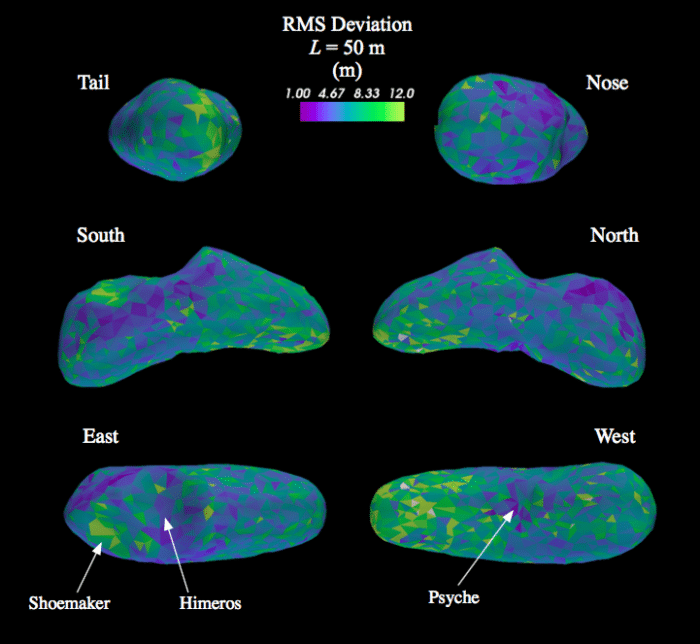
The Near-Earth (not hazardous to Earth) asteroid 433 Eros was explored by the NEAR-Shoemaker spacecraft in 2000-2001. This mission, built and designed by the Johns Hopkins Applied Physics Laboratory, was the first spacecraft to orbit and land on an asteroid. Onboard the NEAR-Shoemaker spacecraft was the NEAR Laser Rangefinder (NLR), which used a laser that bounced off of the asteroid’s surface to measure the shape and topography of 433 Eros.
Since the NEAR-Shoemaker mission, the Hayabusa spacecraft has orbited and mapped the asteroid 25143 Itokawa and now, in 2018, two missions will be visiting and orbiting two new asteroids. Hayabusa2 is currently orbiting 162173 Ryugu, and the OSIRIS-REx mission will arrive at asteroid 101955 Bennu this fall.
One of the important parts of visiting multiple asteroids is comparing each asteroid to other asteroids we have visited in the past; this gives us important insights into the surface geology and interior structure of each of these asteroids. As many of these asteroids are of different sizes (Itokawa is only 0.5 x 0.2 x 0.3 km), scientists look for a quantitative method to compare the surfaces of asteroids to one another. One such method is surface roughness, which is simply the change in topography over a given horizontal length-scale.
In this paper, we (Susorney and Barnouin) used the topography and shape data from NLR to produce the first global surface roughness maps of an asteroid. These maps were used to investigate the surface geology of Eros and to compare Eros to previous limited studies of the surface roughness of other asteroids and to global studies of the Moon.
On Eros, the surface roughness is dominated by the geologically recent Shoemaker impact which produced many boulders that increased surface roughness at smaller horizontal scales. This impact also shook the asteroid erasing craters under 100 m in diameter, which, in turn, reduces surface roughness at longer scales.

Credit: The Bruce Murray Space Image Library, Creative Commons
The surface of Eros was discovered to be very fractal (similar to the Moon), which means that as you increase the horizontal length-scale the surface roughness was measured over, the surface roughness increases at a specific rate. At horizontal scales under 0.5 km, the topography of the Moon and Eros are quite similar, unlike the surface of 25143 Itokawa (where surface roughness was measured for smaller regions), which looks completely different than Eros.
This global dataset for Eros will be a valuable tool to compare to the data returned from 162173 Ryugu and 101955 Bennu in the next year so we can understand more about the diversity of asteroids in our solar system.
These findings are described in the article entitled The global surface roughness of 433 Eros from the NEAR laser rangefinder, recently published in the journal Icarus. This work was conducted by Hannah C.M. Susorney from The Johns Hopkins University and the University of British Columbia, and Olivier S. Barnouin from The Johns Hopkins University Applied Physics Laboratory and The Johns Hopkins University.









